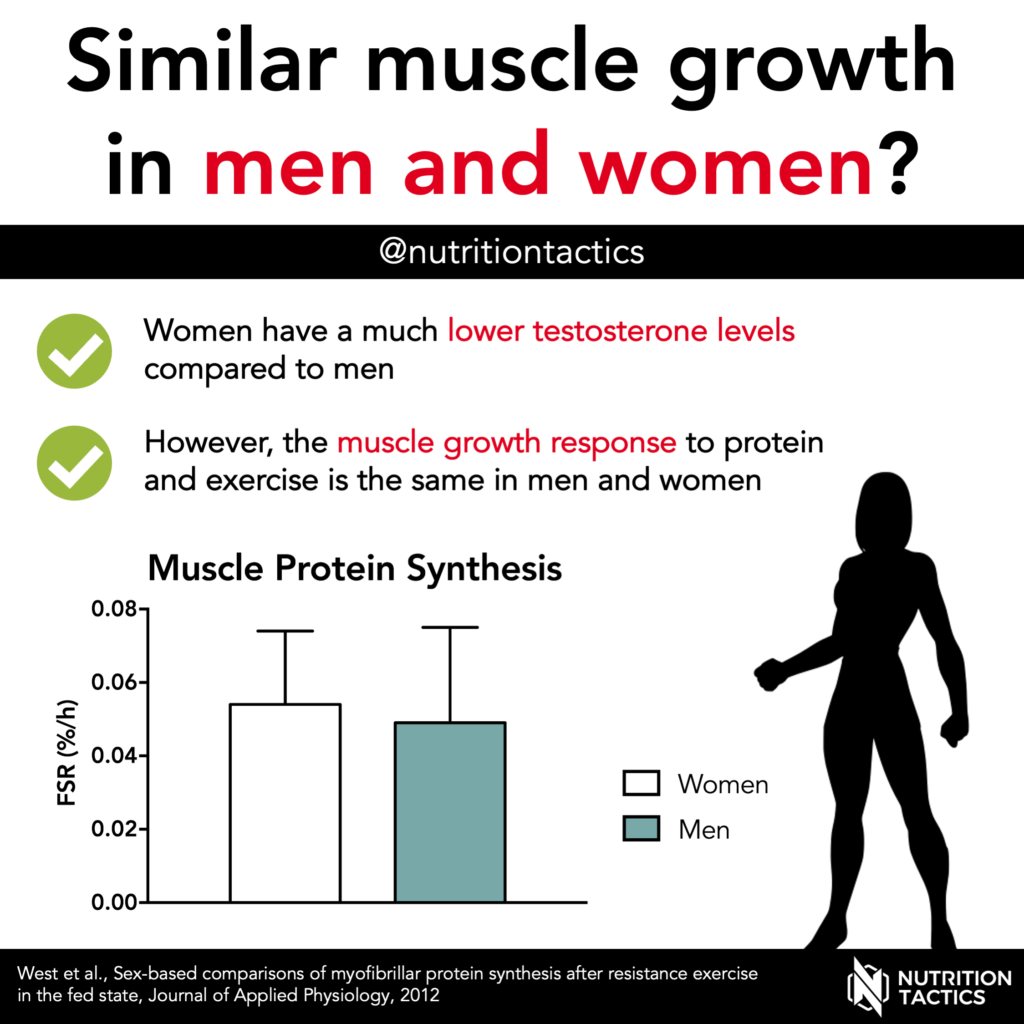Is muscle growth different between women and men?
Men generally have more muscle mass compared to women. Some may suggest that the male sex hormone testosterone is responsible for this, as females have much lower testosterone levels.
This study investigated whether the muscle protein synthetic response (i.e. the underlying process for muscle adaptation) to protein ingestion and resistance exercise is different between men and women.
Women indeed had much lower testosterone levels right after exercise: testosterone was 45 times lower in women compared to men.
However, muscle protein synthesis rates were similar between women and men after a resistance exercise session and protein ingestion.
This finding supports the notion that muscle growth does not rely on post-exercise increases in circulating testosterone (within normal levels).
It should be noted that muscle protein synthesis is relative as it is measured in % per hour. This means that men would still gain more muscle mass during resistance training, because they usually start off with more muscle.
PS: Ladies, gaining muscle mass is still a difficult and slow process. You don’t need to worry about getting “too bulky” accidentally.
Go to the next infographic in the resistance training series:
Imagining exercise can increase strength?


Although the relative muscle increase is the same but the absolute increase is greater for men and that would probably be attributed to testosterone. The fact that men have more muscle mass to start with and still build it at the same rate as women shows testosterone’s anabolic effects because if testosterone had no role men would have built it at a slower relative (it makes sense that something that is already high is harder to increase further than something that is low).
If a man and a woman had the same starting muscle mass, I would expect the man to build at a much higher rate.
Hey Jake,
Your arguments make sense, but physiology is more complicated than that. There are way more differences between males and females than just testosterone. In addition, bigger men also gain faster than smaller men, despite testosterone being similar. It seems the role of testosterone is much smaller than what most people expect.
Ignorance. Learn a little more and try again
Very interesting! I have a question regarding this.
So if MPS is the same in men and women, what is the role of testosterone in building muscle? In another infographic of yours I’ve read that even without resistance training; taking testosterone did increase muscle mass, which would suggest that it does play a role in building muscle.
However, as women have fewer amounts of testosterone than men you’d assume that they build less muscle but this isn’t the case as MPS is the same, as you have demonstrated in this article/infographic. So why does taking testosterone lead to an increase muscle mass even in untrained individuals, but a higher testosterone in men does not lead to (relatively) more muscle mass?
Thanks for answering!
Jan
Hey Jan,
You refer to an infographic in which testosterone injections build muscle mass even without resistance exercise. However, it’s important to realize that those testosterone injections provided supraphysiological amounts of testosterone (higher levels than the body can produce). In fact, the dose was MUCH higher than the body can produce naturally. While males have higher testosterone levels than females, the difference is very small compared to the amounts you would need to inject to start noticing effects on muscle growth. So to summarize: the difference in testosterone between males and females is too small to matter for muscle growth.
But then, why if a man and a woman do the same excercise the woman develop less muscle, if the Muscle Protein Synthesis is the same?
And that keeps me thinking about how valid the proxy Muscle Protein Synthesis is?
Men and women have the same relative muscle growth response to exercise and nutrition (expressed as percentage of starting muscle mass). But women have lower absolute muscle growth response to exercise and nutrition (kg gained), because their starting muscle mass is lower.
Expressed in made up numbers just for simple illustration.
– Women start at 20 kg muscle mass. They gain 20% of muscle mass through training (+4 kg). They end up at 24 kg muscle mass.
– Men start at 30 kg muscle mass. They gain 20% muscle mass through training. The same percentage as females, but it translates to +6 kg because of the higher starting muscle mass. They end up at 36 kg muscle mass.
Muscle protein synthesis is usually expressed as a relative measurement of muscle growth. If you look at the figure, you’ll see it’s expressed as a percentage. If you would express the data as an absolute outcome, females would be lower than males.
So in all reasonableness is it correct to say “men gain more overall muscle”?
Yes.